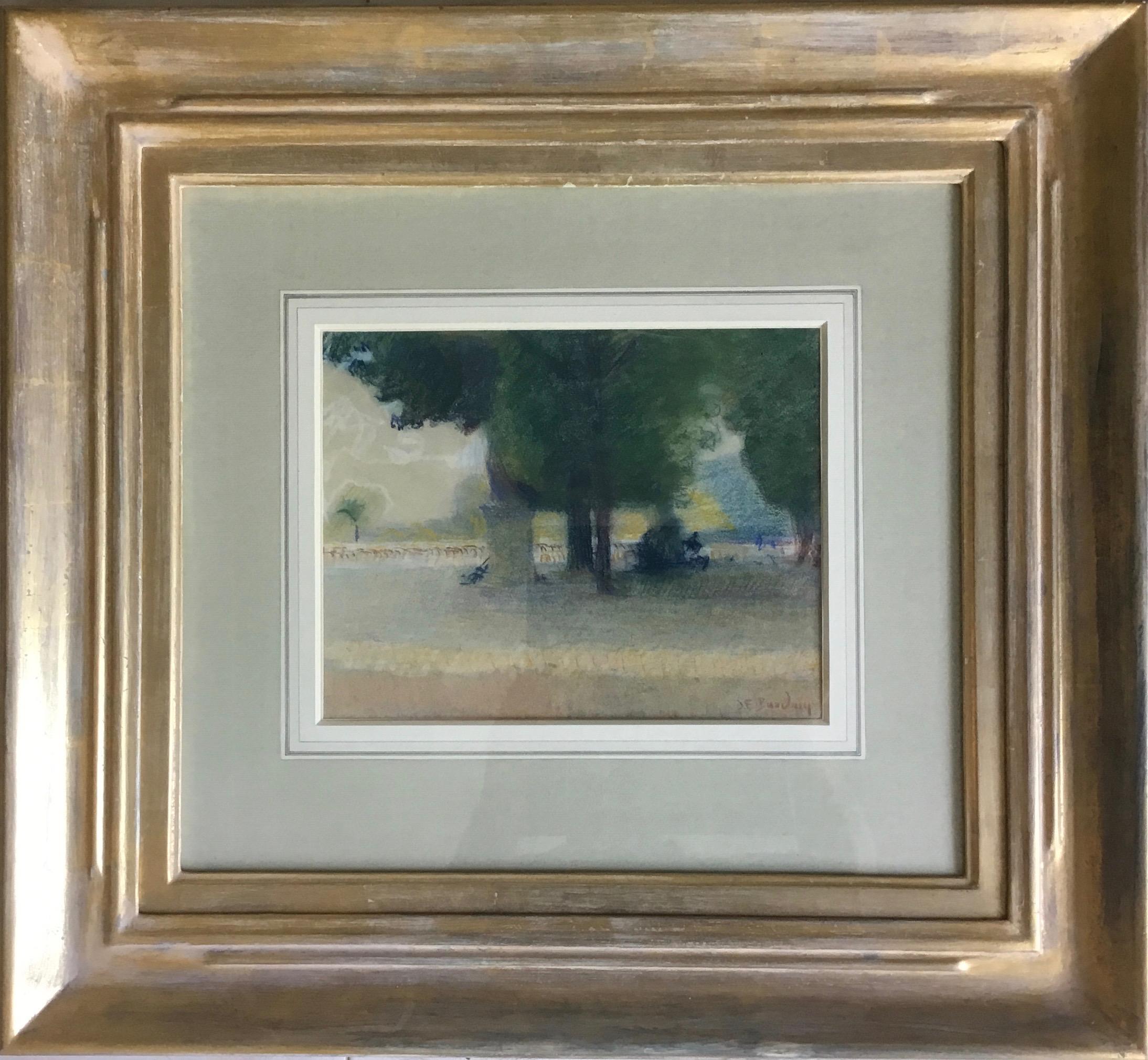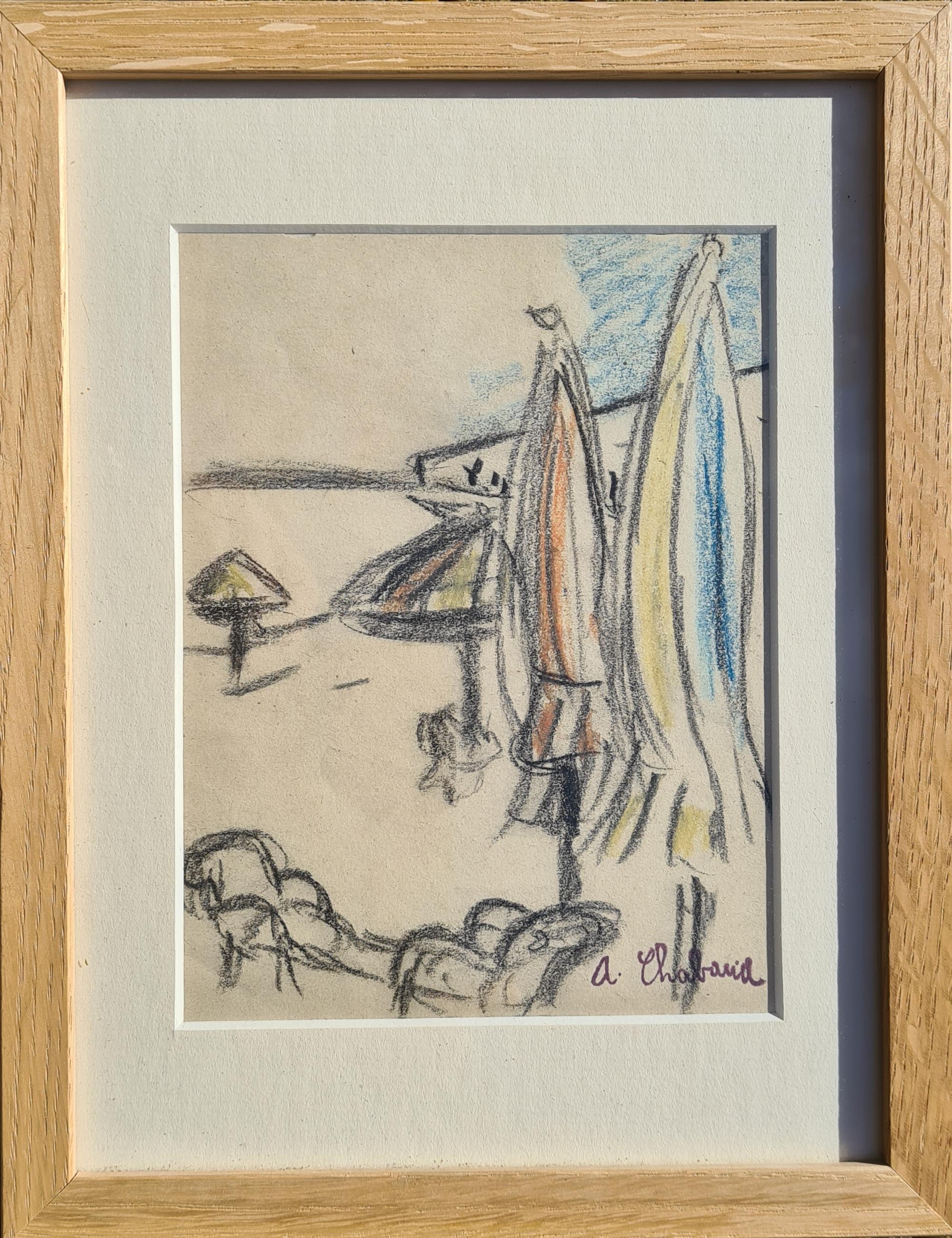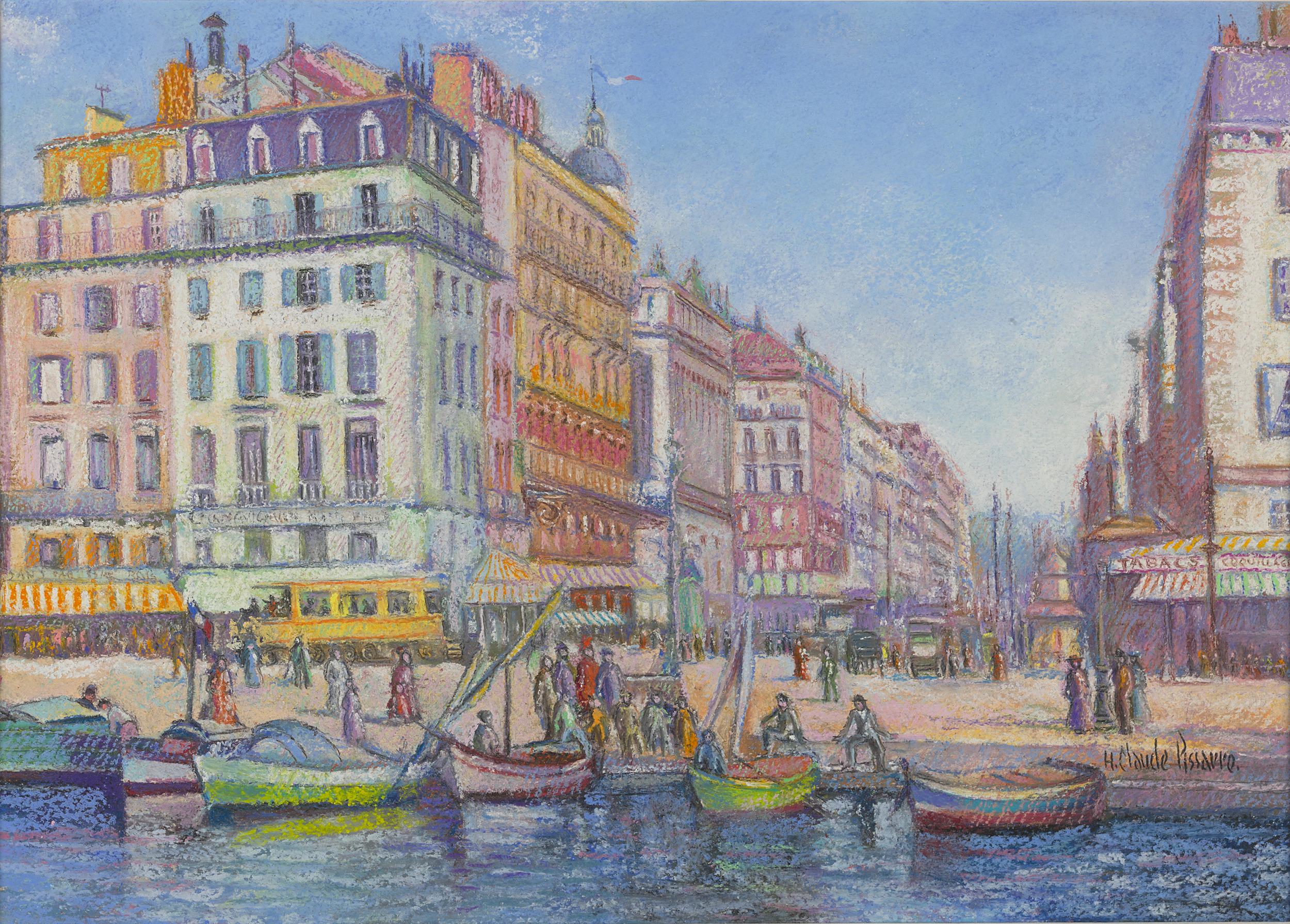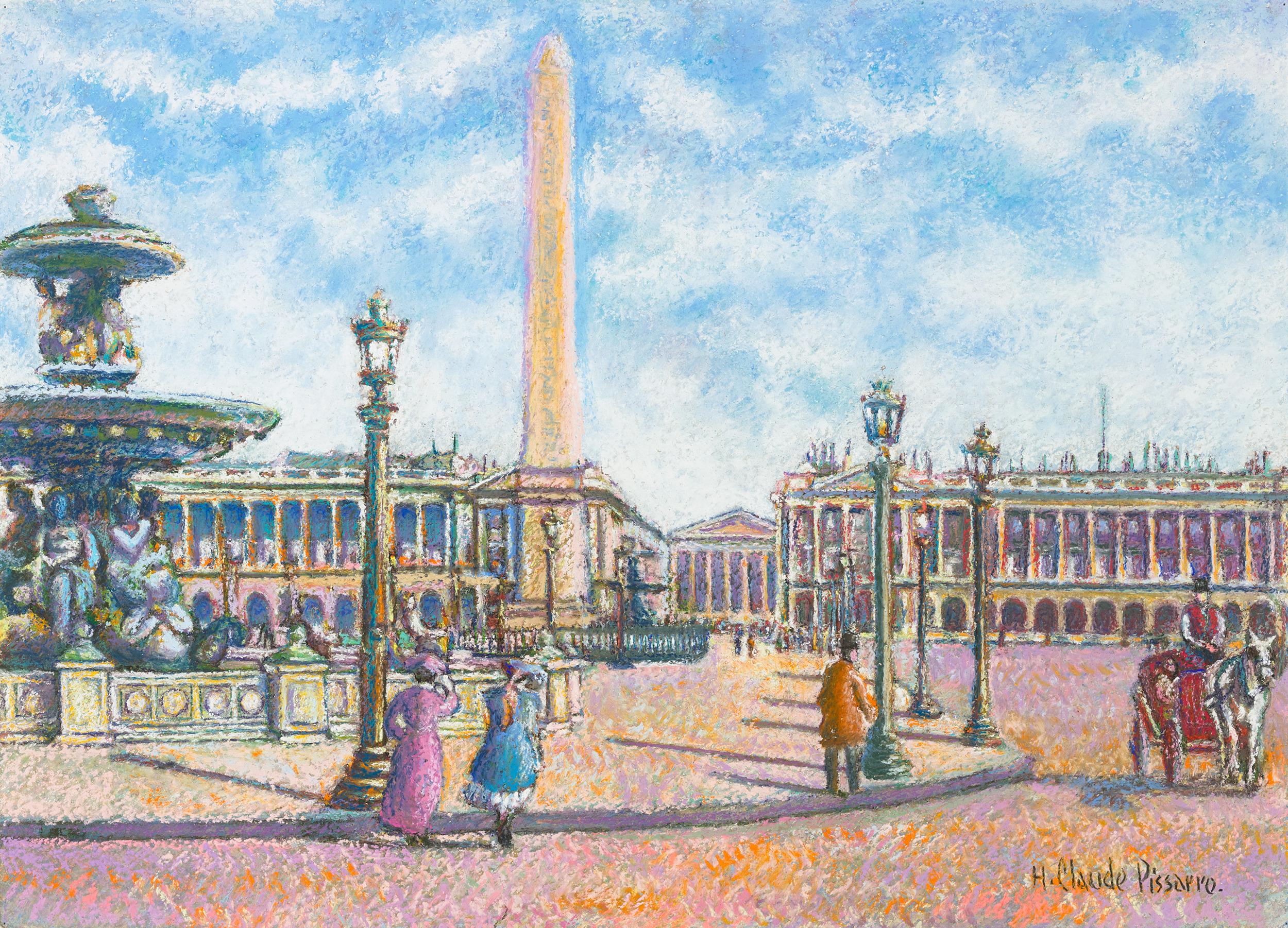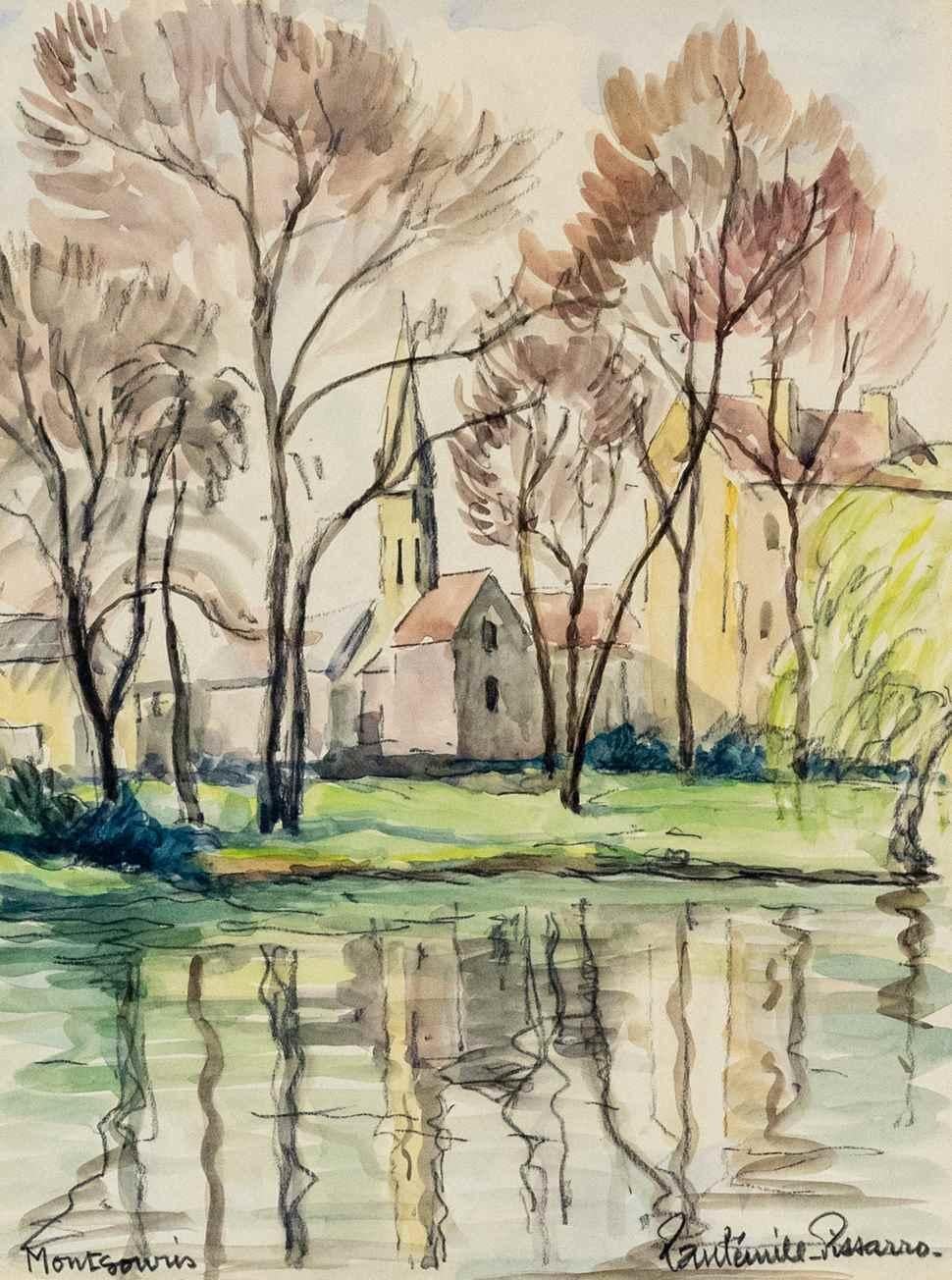Items Similar to Manhattan Skyline
Want more images or videos?
Request additional images or videos from the seller
1 of 8
Leon DoliceManhattan Skyline1930's
1930's
About the Item
Leon Dolice
American, 1892-1960
Manhattan Skyline
Pastel on paper
19 by 12 in. W/frame 25 by 18 in.
Signed lower right
The romantic backdrop of Vienna at the turn of the century had a life-long influence upon the young man who was someday to be spoken of as showing promise of becoming "one of the greatest etchers of all time". Leon Dolice, born in Vienna on August 14, 1892, even as a young boy, preferred the lure of painting to the scholastic studies which his early years had expected of him. His father was a machinist, which exposed the boy to welding and metal crafts.
However, his interest in art led him to abandon a secure future in the family business, and he spent most of his late teens and early twenties traveling through the capital cities of Europe studying the works of the Masters.
As with many itinerant artists, he made his way in a variety of fashions metalworker, chef, designer somehow always managing to give vent to his creative instincts. Lured by the adventure of crossing the great Atlantic and by the freedoms of the New World, he came to America in 1920. There he was greeted by the turbulence of New York in the Roaring Twenties. Finding a retreat in the European Bohemianism of Greenwich Village, he picked the streets of this landmark neighborhood as his first subjects.
With the encouragement of new found friends and artists such as George Luks and Herb Roth, he soon ventured out and devoted all his time to chronicling the architecture, back streets, dock scenes and other nostalgia that was fast disappearing from the face of Manhattan, mainly in copperplate etchings. A favorite subject for him was the Third Avenue El near one of his New York City studios on Third Avenue. He won accolades for his work, and although he traveled the East Coast recording landmarks in other cities including Washington DC, Baltimore, Chicago and Philadelphia, he always returned to his new home Manhattan.
A decline in popular favor for etchings led him to put aside his plates in the late 1930's and devote some ten years to pastels, linocuts and painting. His subject matter was almost exclusively New York City street scenes, but figurative works, country scenes and even experiments with Abstract Expressionism at the height of its new found favor in the 1940's punctuated his career.
In 1953, after learning of the forthcoming demise of the Third Avenue El, in the shadow of which he had maintained his studio for over a decade, he once again took to his plates and press and created a final series of Third Avenue and or other New York City landmarks that were then threatened with extinction. His work brings to light aspects of nostalgic New York that survives today only in small part, whether in architecture or in spirit.
Dolice's works are in a number of notable museums and private collections, including the Museum of the City of New York; The New York Public Library Print Collection; The New York Historical Society; Georgetown University Lauinger Library; The Print Club of Philadelphia and others. In the past few years, his work has been exhibited at Hofstra Museum, Long Island, NY; with the Montauk Artists' Association; Montauk, NY and at Tribeca Gallery New York City.
An exhibition of his works on paper was held from February 28 to March 14, 2003 at the Belleclaire Hotel at 250 West 77th Street and Broadway in New York City. Featuring historic street and landmark scenes of New York City created from 1920 through 1952, it was held as a tribute to New York, which had been sharply in the world's focus following the events of the previous six months.
Provenance:
Private Collection, New York City
Le Trianon Fine Art & Antiques, Sheffield, MA.
Art D60
- Creator:Leon Dolice (1892 - 1960, American, Austrian)
- Creation Year:1930's
- Dimensions:Height: 25 in (63.5 cm)Width: 18 in (45.72 cm)Depth: 1 in (2.54 cm)
- Medium:
- Movement & Style:
- Period:
- Condition:
- Gallery Location:Sheffield, MA
- Reference Number:
About the Seller
3.7
Vetted Seller
These experienced sellers undergo a comprehensive evaluation by our team of in-house experts.
1stDibs seller since 2017
46 sales on 1stDibs
Typical response time: Several days
- ShippingRetrieving quote...Ships From: Sheffield, MA
- Return PolicyThis item cannot be returned.
More From This SellerView All
- Manhattan SkylineBy Leon DoliceLocated in Sheffield, MALeon Dolice American, 1892-1960 Manhattan Skyline Pastel on paper 19 by 12 in. W/frame 25 by 18 in. Signed lower right The romantic backdrop of Vi...Category
1930s Post-Impressionist Landscape Drawings and Watercolors
MaterialsPastel
- VersaillesLocated in Sheffield, MAMarie-Paule Carpentier French, 1876-1915 Versailles Pastel / Paper 12 by 16 in. W/frame 18 by 22 in. Signed on lower left Marie-Paule Carpentier Marie-Paule Carpentier painted i...Category
Early 1900s Impressionist Landscape Drawings and Watercolors
MaterialsPastel
- Place de la MadeleineBy Frank WillLocated in Sheffield, MAFrank Will French 1900-1950 Place de la Madeleine Watercolor on paper 18 by 21 in. w/frame 25 by 27 in. Signed lower left Son of painter Frank Myers Boggs. A Figure from montmatr...Category
1930s Post-Impressionist Landscape Drawings and Watercolors
MaterialsWatercolor
- Flower Market, La Madeleine, ParisBy Antoine BlanchardLocated in Sheffield, MAAntoine Blanchard French, 1910-1988 Flower Market, La Madeleine, Paris Oil on canvas 13 by 18 in. W/frame 19 by 24 in. Signed lower right Provenance: Catalda Fine Arts, Inc., New York Private Collection, New York Trinity House Paintings, London Private Collcetion, New York Alexander Avenard Collection Le Trianon...Category
Mid-20th Century Post-Impressionist Landscape Paintings
MaterialsOil
- Woman and ChildBy John Edward CostiganLocated in Sheffield, MAJohn Edward Costigan, N.A. American, 1888-1972 Woman and Child Oil on canvas Signed ‘J.E. Costigan N.A.’ lower left 24 by 30 in. W/frame 32 by 38 in. John Costigan was born of Irish-American parents in Providence, Rhode Island, February 29, 1888. He was a cousin of the noted American showman, George M. Cohan, whose parents brought the young Costigan to New York City and was instrumental in starting him on a career in the visual arts. They were less successful in encouraging him to pursue formal studies at the Art Students League (where, however, he later taught) than in exposing him to the commercial art world through the job they had gotten him with the New York lithographing firm that made their theatrical posters. At the H. C. Miner Lithographing Company, Costigan worked his way up from his entry job as a pressroom helper, through various apprenticeships, to the position of sketch artist. In the latter capacity he was an uncredited designer of posters for the Ziegfeld Follies and for numerous silent films. Meanwhile, he had supplemented his very meager formal studies in the fine arts with a self-teaching discipline that led to his first professional recognition in 1920 with the receipt of prizes for an oil painting and watercolor in separate New York exhibitions. A year earlier, Costigan had wed professional model Ida Blessin, with whom he established residence and began raising a family in the sleepy little rural New York hamlet of Orangeburg, the setting for the many idyllic farm landscapes and wood interiors with which he was to become identified in a career that would span half a century. John Costigan’s first national recognition came in 1922 with his winning of the coveted Peterson Purchase prize of the Art Institute of Chicago for an oil on canvas, “Sheep at the Brook.” It marked the start of an unbroken winning streak that would gain him at least one important prize per year for the remainder of the decade. The nation’s art journalists and critics began to take notice, making him the recurring subject of newspaper features and magazine articles. The eminent author and critic Edgar Holger Cahill was just a fledgling reporter when he wrote his first feature, “John Costigan Carries the Flame,” for Shadowland Magazine in 1922. Costigan had his first one-man show of paintings at the Rehn Gallery on New York’s 5th Avenue in November, 1924, to be followed less than three years later by another at the Art Institute of Chicago. In addition, Costigan’s work has been—and continues to be included, side-by-side with that of some of America’s most high-profile artists, in museum and gallery exhibitions throughout the country. His renown had peaked in the early 1930s, by which time his work had been honored with nearly every major award then being bestowed in the fine arts and had been acquired for the permanent collections of several prestigious American museums, including New York’s Metropolitan (which only recently, in 1997, deaccessioned his “Wood Interior,” acquired in 1934). Although Costigan’s celebrity had ebbed by the late 1930s, the Smithsonian Institution saw fit in 1937 to host an exhibition exclusively of his etchings. And, in 1941, the Corcoran Gallery (also Washington, D.C.) similarly honored him for his watercolors. (Another Washington institution, the Library of Congress, today includes 22 Costigan etchings and lithographs in its permanent print collection.) During World War II, Costigan returned briefly to illustrating, mainly for Bluebook, a men’s pulp adventure magazine. A gradual revival of interest in his more serious work began at the end of the war, culminating in 1968 with the mounting of a 50-year Costigan retrospective at the Paine Art Center and Arboretum in Oshkosh, Wisconsin. Oils, watercolors and prints were borrowed from museums and private collections throughout the country, and the exhibition was subsequently toured nationally by the Smithsonian Institution. John Costigan died of pneumonia in Nyack, NY, August 5, 1972, just months after receiving his final prestigious award —the Benjamin West Clinedinst Medal of the Artist’s Fellowship, Inc., presented in general recognition of his “...achievement of exceptional artistic merit...” in the various media he had mastered in the course of his career. This painting depicts one of the artist's favorite themes --the farm family bathing...Category
1940s Post-Impressionist Landscape Paintings
MaterialsOil
- Marche de Fleurs, a La Madeleine Paris 1954By Jean SalabetLocated in Sheffield, MAJean Salabet French, 20th Century Marche de Fleurs, La Madeleine Paris Jean Salabet was a School of Paris painter know for his colorful Parisia...Category
1950s Post-Impressionist Landscape Paintings
MaterialsOil
You May Also Like
- SUR LA DORDOGNEJean-Franck BAUDOIN (1870-1961 POST IMPRESSIONISTBy Jean-François BaudoinLocated in Pollenca, Illes BalearesJean-Franck Baudoin a wood engraver and painter of the society of French Artists died on the 20th January 1961 at Libourne ‘Gironde’ at the age of 91. He was born at Saint Martin De ...Category
Late 19th Century Post-Impressionist Landscape Drawings and Watercolors
MaterialsPastel
- LUXEMBOURG GARDENS PARIS.Jean Franck Baudoin (1870-1961) post impressionistBy Jean-François BaudoinLocated in Pollenca, Illes BalearesJean-Franck Baudoin (1870 - 1961) was one of the last great French post impressionist painters."Jean-Franck Baudoin was one of the last great French post-impressionist painters. He g...Category
Late 19th Century Post-Impressionist Landscape Drawings and Watercolors
MaterialsPastel
- Blue Period, Parasols, The Beach, Côté d'Azur.By Auguste ChabaudLocated in Cotignac, FREarly 20th Century French pastel drawing of a beach scene in the South of France by noted fauvist artist Auguste Chabaud. Carrying the stamped atelier signature, possibly from his 'Blue Period'. Auguste CHABAUD was born in Nîmes on October 3, 1882. At the age of fourteen Chabaud joined the Ecole des Beaux-Arts in Avignon. In 1899 he went to Paris to continue his artistic training at the Academie Julian and the Ecole des Beaux Arts. There he met Henri Matisse and André Derain. In 1900 he returned to his parents' vineyard in southern France briefly before returning to Paris. In 1901, he was forced to leave Paris again in order to secure his livelihood. He worked on a ship and got to know the West African coast. Upon his return in 1907 and in the following years, he became acquainted with and captured in his paintings the excitement of the Parisian nightlife. In the Paris neighbourhood Montmartre, where he had his studio, he painted various scenes of Parisian life and cafe society. At the same time, he continued to paint Provence and took part in the Salon des Indépendants and the Salon d’Automne, where he exhibited with the Fauves. Chabaud's Cubist phase began in 1911, where he also began sculpting. In the following years he had many exhibitions, including 1913 in New York, where his works were exhibited alongside those of artists such as Matisse, Derain, Vlaminck and Picasso. After his return from the first World War Chabaud settled down in Graveson. From 1920 he had his "blue period". He used the Prussian Blue as the only colour in his works. From then, he focused exclusively on the south of France. He painted scenes of rural life, the farmers, and the hills and trails of the Alpilles. A very important retrospective exhibition of his work took place in Paris in 1952, which gave him the opportunity to return to Paris, which he had left in 1914. Another retrospective exhibition in Paris took place in 1965 commemorating the tenth anniversary of his death. He died in 1955 in Graveson. In 1966, he was represented at the exhibition “Le Fauvisme français et les débuts de l’impressionnisme Allemand” (French Fauvism...Category
Early 20th Century Fauvist Landscape Drawings and Watercolors
MaterialsCrayon, Paper, Pastel
- Marseille La Cannebière by H. Claude PissarroBy Hughes Claude PissarroLocated in New Orleans, LAHugues Claude Pissarro b.1935 French Marseille La Cannebière (Cannebière street in Marseille Signed “H. Claude Pissarro” (lower right) Pastel on card French artist H. Claude Piss...Category
21st Century and Contemporary Post-Impressionist Landscape Drawings and ...
MaterialsPastel
- La Place de la Concorde, Paris by H. Claude PissarroBy Hughes Claude PissarroLocated in New Orleans, LAHugues Claude Pissarro b.1935 French La Place de la Concorde, Paris Signed “H. Claude Pissarro” (lower right)Pastel on card The architectural beauty of La Place de la Concorde is captured in all of its glory in this resplendent Parisian cityscape by Hugues Claude Pissarro. The celebrated artist renders the site's notable landmarks in detail along with pedestrians in brightly-hued attire, showcasing his deft skill and signature vibrance in the pastel medium. Pissarro captures the detailed edifices in the distance and the sculptural beauty of the square's fountain, using speckled swathes of lavender and orange to render the light of the afternoon sun reflecting from the cobblestone streets. Hailing from a long lineage of artists, including Impressionist Camille Pissarro, Pissarro's artistic talents were cultivated at an early age. He exhibited his first works at the young age of 14 and later studied in Paris at the École du Louvre and École Normale Supérieure. A 1959 White House commission to paint the portrait of President...Category
21st Century and Contemporary Post-Impressionist Landscape Drawings and ...
MaterialsPastel
- Montsouris, Watercolour and charcoal on Paper by Paulémile PissarroLocated in London, GBMontsouris by Paulémile Pissarro (1884 - 1972) Watercolour and charcoal on paper 33 x 25 cm (13 x 9 ⁷/₈ inches) Signed lower right, Paulémile- Pissarro. and titled lower left Execu...Category
1930s Post-Impressionist Figurative Drawings and Watercolors
MaterialsPastel, Paper, Watercolor
Recently Viewed
View AllMore Ways To Browse
Manhattan Art
Paintings Manhattan
Manhattan Painting
Paintings Of Manhattan
Manhattan Framed
Skyline Art
Lower Manhattan
Manhattan Ny Paintings
Antique Drawings America
Antique American Drawings
Public Works 1930s Art
Manhattan Small
Small Antique Drawing
Skyline Painting
City Skyline Art
Vintage Skylines
Manhattan Impressionist
Street Light Post

